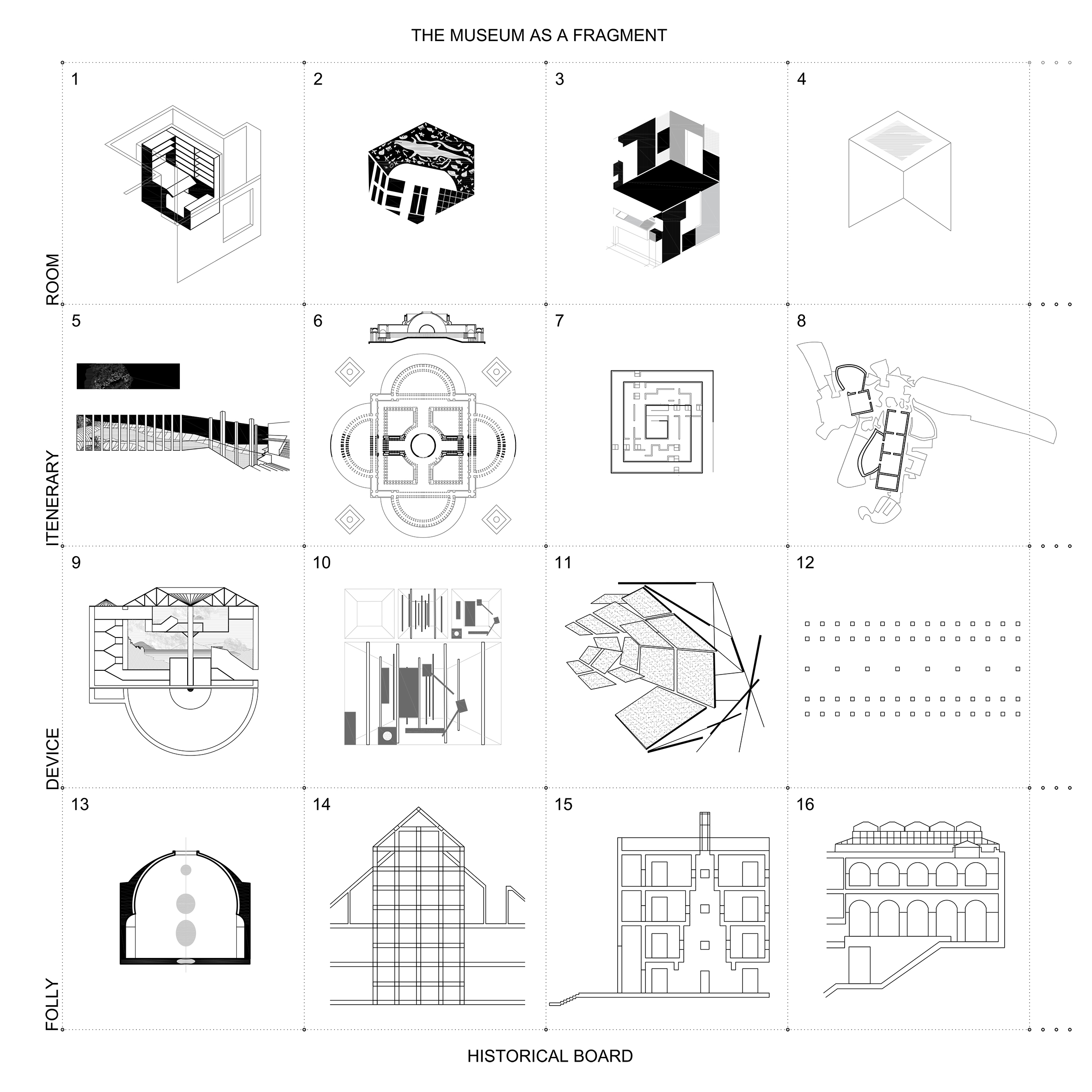A Theory towards a Built-in-Variety in Museum Design: The "Capriccio Museum"
DOI:
https://doi.org/10.31522/p.31.1(65).1Keywords:
Capriccio, neoclassical, museal spaces, museum typology, transhistoricalAbstract
The paper presents an excerpt from the extensive research on various museal spaces throughout human history. By re-evaluating the imaginative procedures involved in conceiving those spaces, the research in its broadest scope asks: how do we map, rethink and revive the historically valuable assets of architectural thought without “museumising” them? The excerpt is initially dedicated to the neoclassical museum space based upon the notion of the frame that was already adopted by the painting genre capriccio to induce the spectator’s mind into an architectural fantasy of juxtaposed real and fictitious buildings, archaeological ruins, urban and natural landscapes. In the neoclassical museum space, the capriccio “became alive” as an actual-size architectural fantasy that could be stepped into. Based upon multiple conceptual frames, the interconnected yet distinct architectural fragments illustrated the neoclassical worldview founded on inclusivity, synchronicity and bodily experience. This historical episode is further theorised into the capriccio museum, a new theoretical model that critically perceives multiple experience probabilities as distilled from the past and starts a process of conversion of that historical knowledge into transhistorical knowledge relevant for today.
References
Anders, S. (2016) ‘Patronage in the Golden Age of the Capriccio’ in Steil, L. (ed.) The Architectural Capriccio: Memory Fantasy and Invention, available from: Routledge Interactive, Taylor & Francis.
Batakoja, M. (2015) Conceptual Interaction between Art Content and Museum Architecture in Art Museum Design (Unpublished Doctoral Dissertation). University of Zagreb, Faculty of Architecture.
Batakoja, M. & Šerman, K. (2021) ‘The Experiential Museum - Avant-Garde Spatial Experiments and the Reorganization of the Human Sensorium’, Architektúra & Urbanizmus, 55 (1-2), 2-17. https://doi.org/10.31577/archandurb.2021.55.1-2.1
Belting, H. (2001) The Invisible Masterpiece. London: Reaktion Books.
Bogdanović, B. (1995) ‘Grad, razoren ili ubien?’, Aršin - spisanije za arhitekturu, urbanizam, dizajn [Богдановиќ, Б. (1995) ’Град, разорен илиубиен?’, Аршин - списание за архитектура, урбанизам, дизај], (1), pp. 44-45.
Brawne, M. (1965) The new museum: architecture and display. Stuttgard: Verlag Gerd Hatje.
Collins, J. (2008-2009) ‘Marshaling the Muses: The Vatican’s Pio-Clementino Museum and the Greek Ideal’, Studies in the Decorative Arts, 16(1), 35-63. https://doi.org/10.1086/652813
Curl, J.S. (1999) Oxford Dictionary of Architecture, Oxford University Press.
Dowling, J. (1977) ‘Capricho as Style in Life, Literature, and Art From Zamora to Goya’, Eighteenth-Century Studies, The Johns Hopkins University Press, 10(4), pp. 413-433. https://doi.org/10.2307/2738565
Duncan, C. (1991) Art Museums and the Ritual of Citizenship. Washington: Smithsonian Insititution.
Ernst, W. (1993) ‘Frames at Work: Museological Imagination and Historical Discourse in Neoclassical Britain’, The Art Bulletin, 75(3), pp. 481-498. https://doi.org/10.2307/3045970
Fabrizi, L. (2019) Inner Space-Constructing the imagination, Lisbon Architecture Triennale/The PoeTics of Reason.
Findlen, P. (1989) ‘The Museum - Its Classical Etymology and Renaissance Genealogy’, ]ournal of the History of Collections, 1(1), pp. 59-78. https://doi.org/10.1093/jhc/1.1.59
Franklin, G. (2012) ‘Built-in variety’: David and Mary Medd and the Child-Centred Primary School, 1944-80’, Architectural History, 55, pp. 321-367. https://doi.org/10.1017/S0066622X00000149
Furján, H. (1997) ‘The Specular Spectacle of the House of the Collector’, Assemblage (The MIT Press), no. 34, pp. 56-91. https://doi.org/10.2307/3171253
Furján, H. (2002) ‘Sir John Soane’s Spectacular Theatre’, AA Files (Architectural Association School of Architecture), no. 47 (Summer 2002), pp. 12-22.
Furján, H. (2004) ‘Scenes from a Museum’, Grey Room (The MIT Press), no. 17, pp. 64-81.
Havik, K. & Sioli, A. (2021) ‘Stories for Architectural Imagination’, Journal of Architectural Education, 75(2), pp. 160-169. https://doi.org/10.1080/10464883.2021.1947670
Hays, K.M. (2016) ‘Architecture’s Appearance and the Practices of Imagination’, Log, vol. 37, 205-213.
Hillier, B. & Tzortzi, K. (2006) ‘Space syntax: The language of museum space’. In: S. Macdonald (Ed.), A companion to museum studies. Blackwell publishing, pp. 281-301.
Huyssen, A. (2006) ‘Nostalgia for Ruins’, Grey Room, The MIT Press, No. 23, pp. 6-21. https://doi.org/10.1162/grey.2006.1.23.6
Kirk, T. (2005) The Architecture of Modern Italy. Volume I: The Challenge of Tradition, 1750-1900. Princeton Architectural Press.
Koolhaas, R. & Obrist, H.U. (2009) ‘An Interview with O.M. Ungers’, Log, (16), 50-95.
Lampugnani, V.M. et al. (2001) Museums for a New Millenium - Concepts, Projects, Buildings. Munich, London, New York: Prestel.
Lee, P.Y. (1997) ‘The Musaeum of Alexandria and the Formation of the Museum in Eighteenth-Century France’, The Art Bulletin, 79(3), pp. 385-412. https://doi.org/10.2307/3046259
Levine, G. et al. (1990) ‘The Simple Day and the Light of the Sun: Lights and Shadows in the Museum’, Assemblage (The MIT Press), no. 12, pp. 58-83. https://doi.org/10.2307/3171116
Lukacher, B. (1983) ‘Phantasmagoria and Emanations: Lighting Effects in the Architectural Fantasies of Joseph Michael Gandy’, AA Files (Architectural Association School of Architecture), no. 4, pp. 40-48.
Mallgrave, H.F. (2005) Modern Architectural Theory - A Historical Survey 1673-1968. Cambridge University Press. https://doi.org/10.1017/CBO9780511497728
Mallgrave, H.F. (Ed.) (2006) Architectural Theory Volume I: An Anthology from Vitruvius to 1870. Blackwell Publishing.
Marchesano, L. (2010) ‘Invenzioni capric di carceri: The Prisons of Giovanni Battista Piranesi (1720-1778)’, Getty Research Journal, The University of Chicago Press on behalf of the J. Paul Getty Trust, No. 2, pp. 151-160. https://doi.org/10.1086/grj.2.23005415
Marotta, A. (2010) Contemporary Museums. Milano: Skira.
Marotta, A. (2012, December 19) ‘Typology Quarterly: Museums’, Architectural Review.
Marx, L. (1992) ‘Does Pastorialism Have a Future?’, Studies in the History of Art, National Gallery of Art, no. Symposium Papers XX: The Pastoral Landscape, pp. 208-225.
Mata, L.D. (2006) The Vatican Museums. Edizioni Musei Vaticani, Vatican City State.
Mayernik, D. (2016) ‘Meaning and Purpose of the Capriccio’. In: Steil, L. (ed.) The Architectural Capriccio: Memory Fantasy and Invention, available from: Routledge Interactive, Taylor &Francis.
Mazzola, E.M. (2016) ‘Capricci Capricciosi’. In: Steil, L. (ed.) The Architectural Capriccio: Memory Fantasy and Invention, available from: Routledge Interactive,Taylor & Francis.
Montaner, J.M. & Oliveras, J. (Eds.) (1987) The museums of the last generation. Stuttgart, Zürich: Karl Krämer Verlag.
Naredi-Rainer, P.V. (2004) A design manual: Museum Buildings. Basel, Berlin, Boston: Birkhäuser.
O’Doherty, B. (1986) Inside the White Box - The Ideology of the Gallery Space. The Lapis Press.
Pevsner, N. (1976) A History of Building Types. Princeton University Press.
Pinto A.J. (2016) ‘Speaking Ruins: Travelers’ Perceptions of Ancient Rome’, SiteLINES: A Journal of Place, Foundation for Landscape Studies, 11(2), pp. 3-5.
Popiel, M. (2015) ‘The Aesthetics of Caprice: In the Circle of Visualization’, Visual Literacy (Institute of Literary Research Polish Academy of Science), 2(8), pp. 200-211. https://doi.org/10.18318/td.2015.en.2.13
Psarra, S. (2009) ‘Chapter 5: Soane through the looking glass - The house-museum of Sir John Soane’. In: Psarra, S.: Architecture and Narrative: The Formation of Space and Cultural Meaning, pp. 112-135, Routledge.
Steil, L. (ed.) (2016) The Architectural Capriccio: Memory Fantasy and Invention, available from: Routledge Interactive, Taylor & Francis. https://doi.org/10.4324/9781315241326
Steil, L. (2016a) ‘Preface: The Architectural Capriccio: Memory Fantasy and Invention’. In: Steil, L. (ed.) The Architectural Capriccio: Memory Fantasy and Invention, available from: Routledge Interactive, Taylor & Francis. https://doi.org/10.4324/9781315241326
Steil, L. (2016b) ‘The Grand Tour’. In: Steil, L. (ed.) The Architectural Capriccio: Memory Fantasy and Invention, available from: Routledge Interactive, Taylor & Francis. https://doi.org/10.4324/9781315241326
Vidler, A. (1989) ‘Losing Face: Notes on the Modern Museum’, Assemblage, (9), pp. 40-57. https://doi.org/10.2307/3171151

Downloads
Published
How to Cite
Issue
Section
License
Copyright (c) 2023 Meri Batakoja

This work is licensed under a Creative Commons Attribution 4.0 International License.
Copyright (c) 2021 authors and journal.
This work is licensed under a Creative Commons Attribution 4.0 International License.
Authors who publish with this journal agree to the following terms:
In agreeing this form, you certify that:
- You read the ethical codex of the PROSTOR available at journal web.
- You submitted work is your original work, and has not previously been published and does not include any form of plagiarism.
- You own copyright in the submitted work, and are therefore permitted to assign the licence to publish to PROSTOR.
- Your submitted work contains no violation of any existing copyright or other third party right or any material of an obscene, libellous or otherwise unlawful nature.
- You have obtained permission for and acknowledged the source of any illustrations, diagrams or other material included in the work of which you are not the copyright owner.
- You have taken due care to ensure the accuracy of the work, and that, to the best of your knowledge, there are no false statements made within it.
- All co-authors of this submitted work are aware of, and in agreement with, the terms of this licence and that the submitted manuscript has been approved by these authors.






